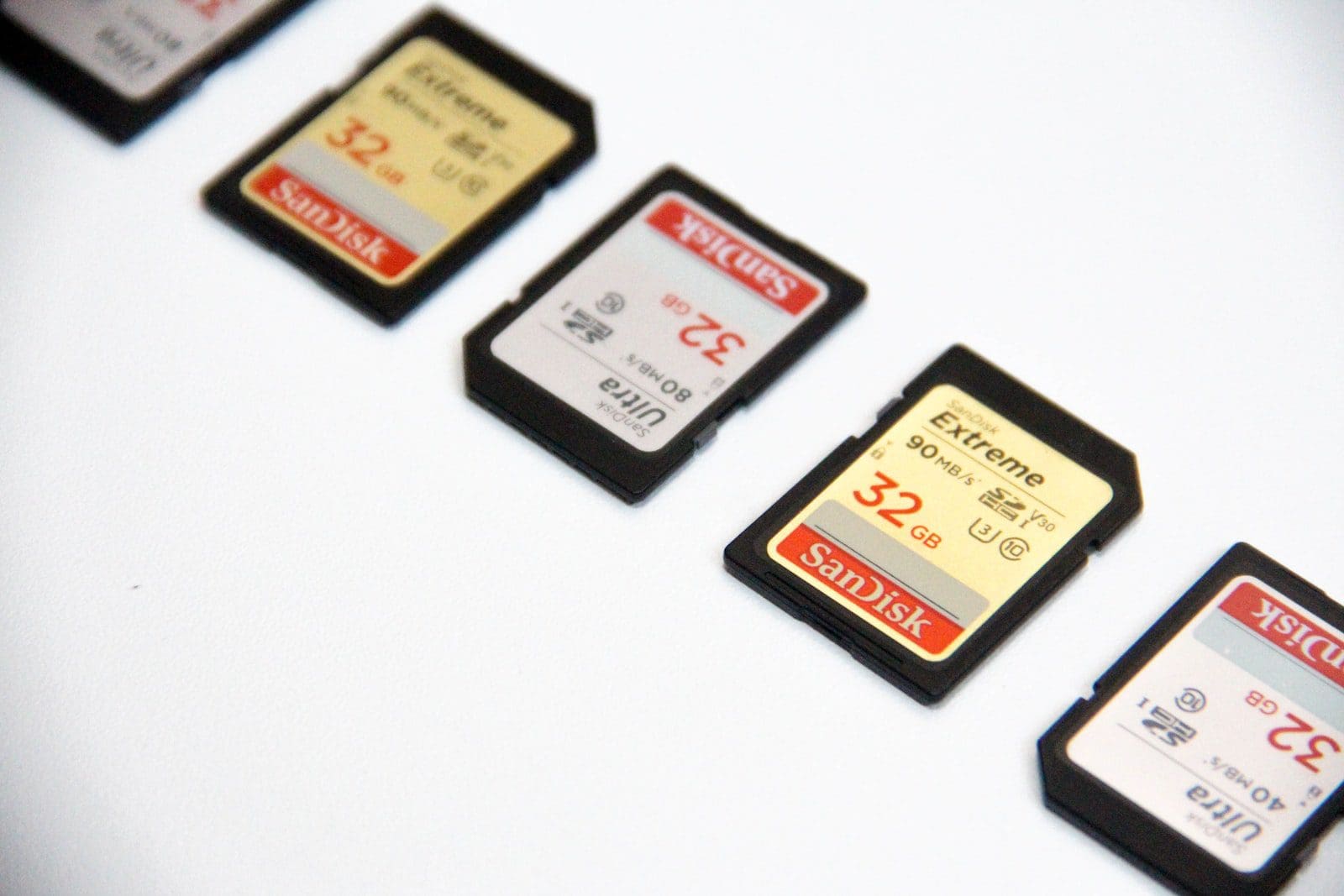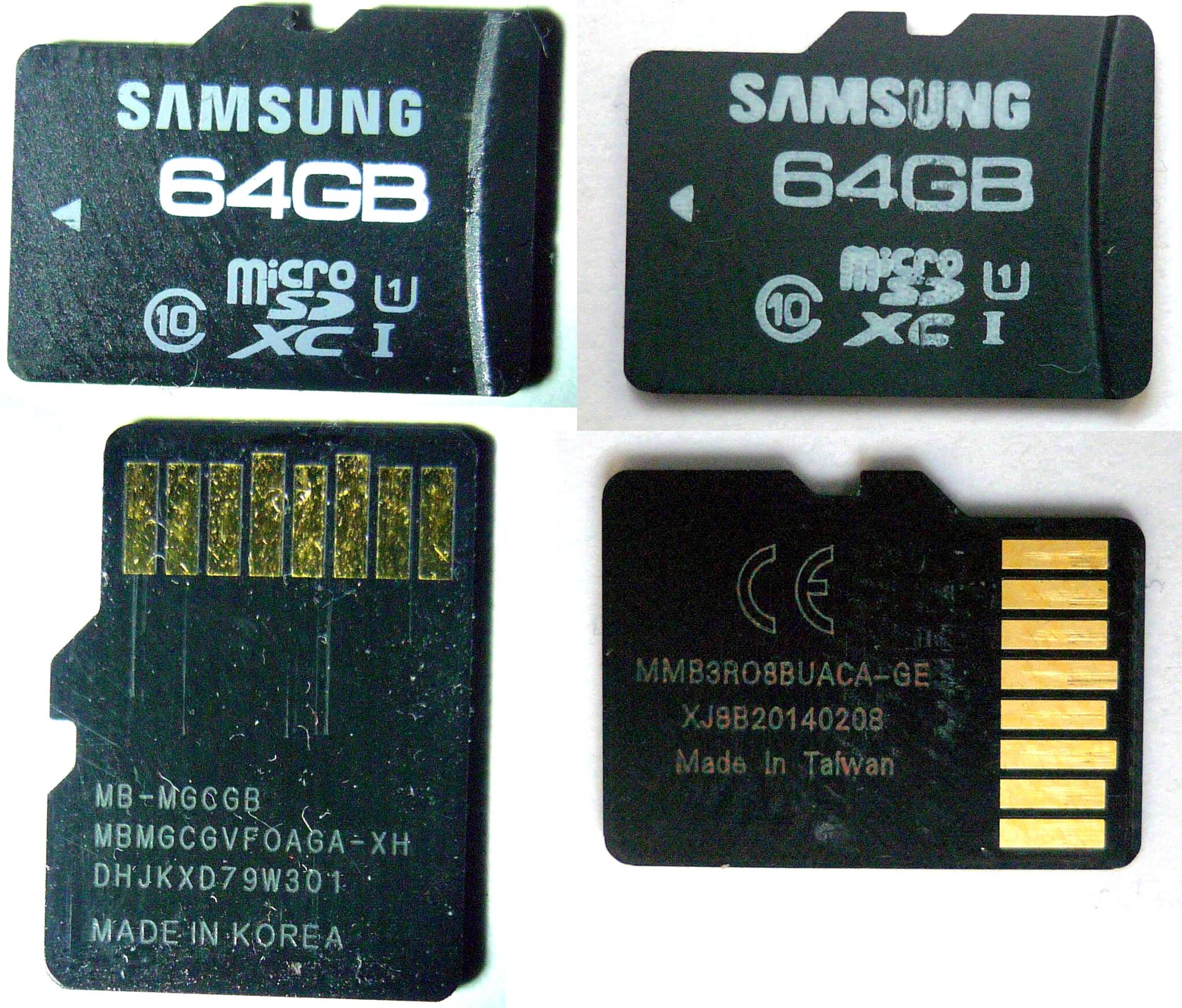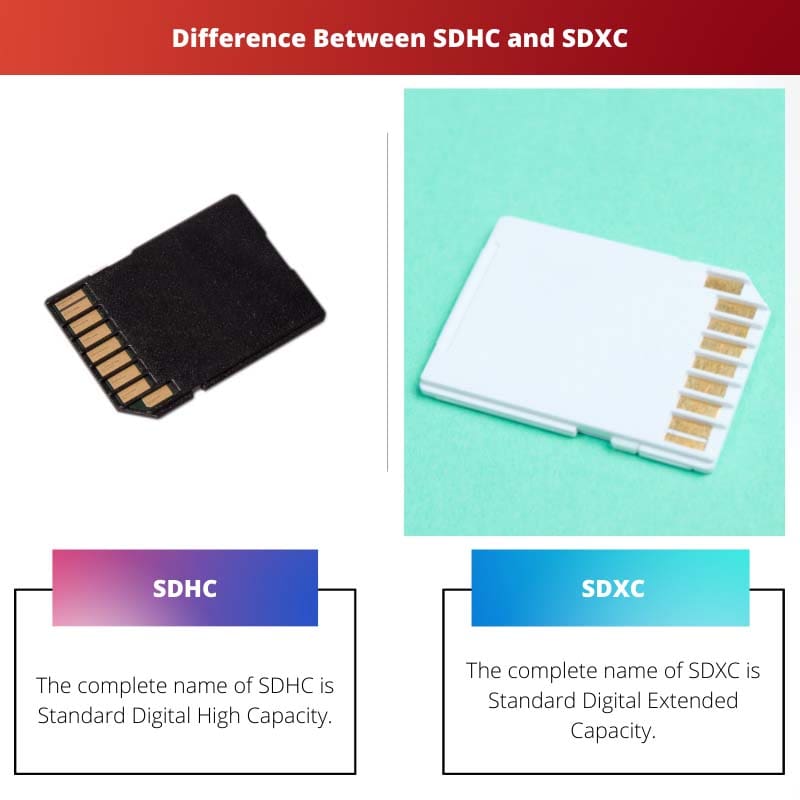Data can be collected in many forms, and if the amount of Data is large, then obviously, a person would need a large place to store them.
The same goes for digital data, such as PDFs, images, videos, etc. When the quality gets better, they require more space. That’s when memory cards like SDHC and SDXC come in handy.
Key Takeaways
- SDHC (Secure Digital High Capacity) cards store up to 32GB of data, while SDXC (Secure Digital Extended Capacity) cards can store up to 2TB.
- SDXC cards have faster read/write speeds than SDHC cards, making them better suited for high-performance applications.
- SDHC and SDXC cards are only sometimes interchangeable, as some devices only support specific card types.
SDHC vs SDXC
The difference between SDHC and SDXC is that the storage capacity of SDHC is 4 GB to 34 GB, while the storage capacity of SDXC is 34 GB to 2 TB (terabyte). The same company manufactures both and has the same dimensions. They are used in devices that are compatible with them.

SDHC is a secure digital flash memory card that is used to store data. SDHC cards have a high capacity for data storage. They have replaced SD cards.
The services provided by SDHC cards are very different from standard SD cards. It comes with the SDA 2.0 specification and now has countless users.
SDXC card is an enhanced version of SDHC. It is a memory card used in multiple portable devices to store data. It was manufactured especially for video cameras or camcorders.
Camcorders need a high-capacity storage card because they record videos in high resolutions. SDXC can be installed on any device, and it is made for specific devices.
Comparison Table
| Parameters Of Comparison | SDHC | SDXC |
|---|---|---|
| Full form | The complete name of SDHC is Standard Digital High Capacity. | The complete name of SDXC is Standard Digital Extended Capacity. |
| Capacity | The SDHC card has a capacity of 4 GB to 34 GB. | The SDXC card has a capacity of 64 GB to 2 TB. |
| Usage | The SDHC cards are used in a smartphone, digital camera, eBook, etc. | The SDXC card is mostly used in camcorders and other professional cameras. |
| Resolution | The SDHC card can store videos and pictures of Full HD. | The SDXC card can store pictures and videos in 4k. |
| Transfer speed | The SDHC card provides up to 10mb/s data transferring speed. | The SDXC card provides up to 300mb/s data transferring speed. |
What is SDHC?
The long term for SDHC is Secure Digital High Capacity. It is an enhanced version of SD cards. It provides storage of up to 32 GB. The workflow of an SDHC card is far different than an SD card.
There are 3 types of these cards; the first is SDHC with the dimension of 32*24*2.1mm, the second is Mini SDHC with the dimension of 21.5*20.1.4mm, and the third is Micro SDHC with the dimension of 15*11*1.0mm.
It can be used in portable devices such as smartphones and cameras. If the device is designed keeping in mind the sd card, then there is a possibility that the SDHC card will not work in these devices.
While an SD card can work in an SDHC device, its performance might be low. The range of capacities the SDHC card provides is 4 GB, 8 GB, 16 GB, and 32 GB.
It was launched to fulfil the increasing demand for high-definition videos. Modern cameras capture or record video in high resolution, so the need for larger storage is increasing.
SDHC cards are the best solution to this problem. Any SD card which has a storage capacity of more than 4 GB is considered an SDHC card.

What is SDXC?
SDXC card is known to be the largest flash memory card. It was launched in 2010. It is a short term for Secure Digital Extended Capacity.
The main feature of the SDXC card is that it has the same dimensions as SDHC and SD cards, but the facilities it provides are more.
The speed of recording and storing high-resolution videos and pictures are quite higher if the SDXC card is used. But because of its structure, it is only compatible with devices focused on this card.
The speed it provides is almost 104/s to 300/s. The storage capacity in SDXC cards begins from 64 GB, which can be extended up to 2 TB.
It can also be used in portable devices such as eBooks, digital cameras, smartphones, camcorders, etc. The DTR ( data transferring rate) has been upgraded in SDXC cards.
It was mainly launched for camcorders because they record HD videos and require more space than other devices. Yet it can be used on particular devices.
The SD Association manufactures these memory cards, the same company that makes standard SD cards. The file system used by SDXC cards is called exFAT. Unlike SDHC, these cards are based on the specification, which is SDA 3.0.

Main Differences Between SDHC and SDXC
- The file format system in SDHC is read as FAT32. On the other hand, SDXC has an exFAT file format system.
- The SDHC card comes with 2.0 specifications, while the enhanced version SDXC card comes with 3.0 specifications.
- The SDHC card can provide up to 32 GB storage, while SDXC provides up to 2 TB storage for data storage.
- 10 Mbps is the maximum data transferring speed in SDHC, while SDXC provides 300 Mbps data transferring speed to the users.
- The SDHC card can hold Full HD videos and pictures in JPEG format, while SDXC can store 4k videos and pictures along with RAW and JPEG.


Great post explaining the differences between SDHC and SDXC. The information provided is very thorough and easy to understand.
The post provided a clear explanation for those who are unfamiliar with SDHC and SDXC. However, I would have liked to see more real-world examples of devices where these cards are used.
The detailed information about the file format system, specifications, and storage capacities of SDHC and SDXC cards was incredibly helpful. Great job!
I appreciate the detailed explanation on what SDHC and SDXC are and their main differences. The information was presented clearly.
Very informative post! Thanks for sharing this knowledge.
Yes, it was quite detailed. The comparison table was very useful.
The comparison of the transfer speeds between SDHC and SDXC cards was enlightening. The technological advancements are remarkable.